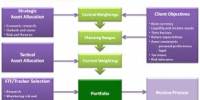Uncovered interest arbitrage is an investment strategy where a domestic currency with a low-interest rate is switched to foreign currency to be able to earn higher interest. It is an arbitrage trading strategy whereby an investor capitalizes on the interest rate differential between two countries. It’s an investment strategy where you convert a domestic currency with a low-interest rate to foreign currency with higher interest to try to profit from it. The strategy involves risk, as an investor exposed to exchange rate fluctuations is speculating that exchange rates will remain favorable enough for arbitrage to be profitable. It’s ‘uncovered’ because the exchange rate risk isn’t hedged through a forward contract.
Explanation
Suppose the risk-free rate for currency B is higher than that for currency A, and that the difference in interest rates is greater than the expected depreciation of currency B against currency A (both over the same period).
- Sell currency A and buy B.
- Invest the amount of B bought is risk-free securities.
- When the securities mature convert the holding of B back to A.
If currency A is borrowed, then this is called a carry trade (because the interest on the borrowed amount is a carrying cost). Uncovered interest arbitrage assumes that, on average, an investor who borrows in a low-interest rate country, converts the funds to the currency of a high-interest rate country, and lends in that country will not realize a profit or suffer a loss.
This form of arbitrage has become quite popular in various sectors of the financial markets, but it’s less common than covered interest arbitrage, which doesn’t carry as much risk as it’s protected with a forward contract. The opportunity to earn profits arises from the reality that the uncovered interest rate parity condition does not constantly hold—that is, the interest rate on investments in one country’s currency does not always equal the interest rate on foreign-currency investments plus the rate of appreciation that is expected for the foreign currency relative to the domestic currency. While this strategy can be profitable, it can also be risky as exchange rates fluctuate. When a discrepancy between these occurs, investors who are willing to take on risk will not be indifferent between the two possible locations of investment and will invest in whichever currency is expected to offer a higher rate of return including currency exchange gains or losses (perhaps adjusted for a risk premium). You’re speculating that rates will remain in your favor for you to gain, but adverse currency movements can eradicate all the profits and even lead to negative returns.
















